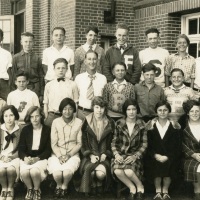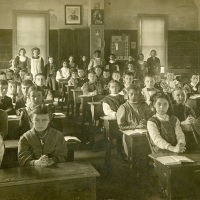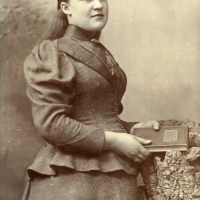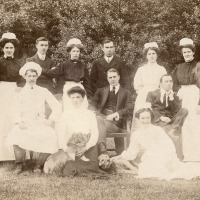This undated cabinet card portrait was taken in the ancient shipping town of Gravesend, Kent, England. Gravesend is on the south bank of the Thames Estuary, about 21 miles (35 km) from central London. The photograph was taken at the studio of Frederick Charles Gould, who became known for images he captured of the many ships that came to Gravesend to load and unload passengers and cargo.
The man in the portrait isn’t identified. On the back, someone wrote a name with question marks: Mr. Francis Grandling??

According to Google and Ancestry, no record exists of any man named Francis Grandling! Either the name was misspelled on the photo, or I’m reading it wrong, or I didn’t search hard enough.
Having failed to find the good Mr. Grandling in the historical record, I wondered if the hymn numbers next to him might tell us something. Did he choose those hymns for a reason? Unfortunately, without knowing the year of the photo, it’s hard to be sure which hymnal the numbers were derived from. The hymnal may have been Hymns Ancient and Modern, used by the Church of England. Editions were published in 1861, 1875, 1889, and 1904. I’d guess that the cabinet card was made in the 1890s, which would mean that the 1889 edition was probably in use at the time. On the other hand, if the photo was taken before 1889, the 1875 edition would have been in use. Frustratingly, hymn numbers don’t correspond between the two editions. I looked at the relevant hymns in both editions online. Since the 1889 edition is more likely to be relevant, I’ll share some of what I found in it.
Of the five hymns listed on the board in the photo, only the first one (373) has a name: In Times of Trouble. The first verse:
God moves in a mysterious way
His wonders to perform;
He plants His footsteps in the sea,
And rides upon the storm.
Knowing that seafaring was a big part of life in Gravesend, my attention was immediately drawn to the reference to the sea in the verse above.
The second hymn in the photo is number 184. The fourth and final verse:
While I draw this fleeting breath,
When my eyelids close in death,
When I soar through tracts unknown,
See Thee on Thy Judgment Throne:
Rock of ages, cleft for me,
Let me hide myself in thee.
Tracts unknown seems to refer to a journey taken after death, but the words might have had special resonance for sailors heading out on a dangerous journey to distant lands.
The third hymn in the photo is number 193. The first verse:
Jesus, Lover of my soul,
Let me to Thy Bosom fly,
While the gathering waters roll,
While the tempest still is high:
Hide me, O my Saviour, hide,
Till the storm of life is past;
Safe into the haven guide,
O receive my soul at last.
The fourth hymn in the photo is number 264. The first verse:
My God, my Father, while I stray,
Far from my home, on life’s rough
O teach me from my heart to say,
Thy will be done.
The fifth and last hymn in the photo is number 176. The first three verses:
How sweet the Name of Jesus sounds
In a believer’s ear!
It soothes his sorrows, heals his wounds,
And drives away his fear.
It makes the wounded spirit whole,
And calms the troubled breast;
‘Tis manna to the hungry soul,
And to the weary rest.
Dear Name! the rock on which I build,
My shield and hiding-place,
My never-failing treasury fill’d,
With boundless stores of grace.
In the first verse, the theme of fear is introduced, but in the third verse, Jesus is the rock and hiding-place (refuge) of the believer.
After I read through the hymns, it seemed clear that they might have been selected to resonate with a seafaring congregation. I searched online again to see if I could find any more references to Gould, the photographer. I came across an interesting recent blog post by Graham Thompson, Archives Assistant at the National Maritime Museum in Greenwich, London. The title of the post is Pastoral care on the waterfront: The work of St Andrew’s Waterside Church Mission. A photo by F.C. Gould & Son is used to illustrate the text. Mr. Thompson writes:
While seamen have faced many dangers and uncertainties at sea, mission societies such as St Andrew’s have supported and cared for their welfare through religious services and the provision of books – both at sea and on land.
The isolation and anxiety felt by many during the coronavirus lockdown has been likened to the uncertainties routinely faced by seafarers. Many different mission societies have existed to support the welfare of individuals facing dangers and isolation at sea.
Among them was the St Andrew’s Waterside Church Mission, established in 1864 to serve the spiritual needs of merchant seamen, fishermen and emigrants passing through the Church of England parish of Holy Trinity at Milton-next-Gravesend. Its work among the waterfront communities of the River Thames was replicated at branches in ports at home and abroad before it merged with the Missions to Seamen in 1939.
Another quick search online turned up a description of the founding of St. Andrews Mission House. The description is so vivid and interesting that I’ve copied all of it below. The highlights are mine:
St. Andrews Church was built to serve Gravesend’s waterside community. In the mid 19th century, the river Thames just off Gravesend was alive with vessels of all shapes and sizes waiting to load cargoes, or passengers and emigrants heading for Australia, New Zealand and the Americas. Smaller boats supplied the everyday needs of the larger ships, and the crews of these boats lived with their families and livestock on board a collection of hulks and old barges moored just offshore. The priest of the local Holy Trinity Church, Rev C E R Robinson, looked upon these people as his parishioners and began visiting them. He also extended his services to the emigrants who lived on board their ship, often in appalling conditions, and often for weeks before they sailed. Over 600 baptisms are recorded for emigrants wanting to be blessed before their departure.
It soon became necessary to have a headquarters for the mission and the former public house, the Spread Eagle, was taken over. Services were held in the bar and classes taught in a small adjoining hut. Rev Robinson wrote to a London church newspaper asking for donations to help build a mission hall, and the daughter of Rear Admiral Francis Beaufort KBE responded.
Donations were received from other townsfolk including Charles Dickens. On St Peter’s day 1870 the foundation stone was laid and the church was finished and consecrated on St Andrew’s Day in 1871. Inside, the ceiling is constructed to resemble an up-turned boat. Memorials include one to Sir John Franklin’s ill-fated Arctic exhibition on board the Erebus and Terror which set out from Gravesend.
The primary missionary purpose of the church was transferred to Tilbury when the docks were built, but services continued until 1971 despite ongoing problems with damp. The Diocese of Rochester decided to close the church because of the cost of repairs, but it was rescued and purchased by Gravesham Borough Council in 1975 and transformed into an Arts Centre.
While it’s impossible to be certain without identifying him, it seems likely that the man in the portrait below was an organist and choirmaster at St Andrew’s Waterside Church.
This post became much longer than I intended, so I hope you’ve enjoyed this foray into the history of Gravesend, inspired by a choirmaster and a set of hymns.












I love this image SO much, AND your accompanying essay. I certainly agree that those numbers of the hymns seem prominent enough to suggest the hymns must have some special significance.
LikeLiked by 4 people
Thank you so much, Carol! When I looked at the hymns in the 1875 hymnal, I didn’t notice any common themes. When I looked at them in the 1889 hymnal, the selection seemed much more intentional. It was really fun to investigate, and I’m so glad you enjoyed it!
LikeLiked by 1 person
Hymns can be inspiring! I enjoyed it all.
LikeLiked by 4 people
They’re very poetic, aren’t they? Thank you so much, Jo Nell!
LikeLike
It does seem like the hymns you found fit the story well. All of them of importance to seamen. Love how you found out so much more to go with the photo by researching the hymn numbers!
LikeLiked by 5 people
It was fun to investigate, but I wasn’t sure if I’d find anything worth sharing. Then the post ended up being really long! I try not to overwhelm readers with information that might not be interesting to them, but in this case I couldn’t resist. Thank you, Thérèse!
LikeLike
Well done, Brad!💪👍
LikeLiked by 1 person
The hymnboard is certainly an interesting and unique prop. I imagine the sitter turning up to the studio with it in hand, intent on directing exactly how the resulting image should appear.
On the name: I find nothing for “Grandling” either. The closest I can come to a name which definitely exists is “Grandin”, but that still doesn’t turn up anything linked to Gravesend.
LikeLiked by 3 people
You made me smile with your vision of the gentleman arriving at the studio with his hymnboard. 🙂
I also considered Grandin, along with Grandlins, but didn’t find anything. I wrote to the Royal Maritime Museum yesterday, but they’re closed right now due to coronavirus restrictions. Maybe someone will reply in a few weeks and solve the mystery!
LikeLiked by 2 people
Fab research and he looks a kindly soul.
LikeLiked by 4 people
I wondered if he might be a priest, but his vestments would be more elaborate, I think. Cheers, CJ!
LikeLiked by 1 person
Very impressive research! He does look kind and happy to serve.
LikeLiked by 4 people
I wonder if he went out onto ships to lead hymns. He would have seen some really interesting things. Thank you, Morgaine! 🙂
LikeLike
Wonderful post, despite its unsolved central mystery. I love the history behind it all as well as the hymns’ lyrics. What an inauspicious name Gravesend is! Many of our inquiries are stymied by the much diminished Google search engine. It used to be more comprehensive and detailed but lately seems determined by commercial value and/or most popular searches. The minutia we’ve come to love has vanished into the ether. AI is determining what we’re allowed to see, when once upon a time all was easily retrieved. Still, we’re lucky to have even a lesser Library of Alexandria. Someday Google may be merely a legend as well. Mr. Grandling may not have made the cut, but there’s no doubt his contribution to that community was inestimable 🙂
LikeLiked by 3 people
I’ve begun using JSTOR for some of my research, precisely because Google is becoming less and less useful. Even though I’m not affiliated with an institution that provides full access to JSTOR, you can “check out” several articles at a time, and then return them in order to search for more. It’s been useful.
LikeLiked by 3 people
Thank you!
LikeLike
I’ve never registered with JSTOR, but I’ve heard from others that it’s useful. Clearly I need to sign up!
LikeLike
Yes, Google and other search engines will undoubtedly be replaced by more efficient and comprehensive systems eventually. Still, I get the feeling that the information currently available on the web is really just the tip of the iceberg. Some is kept offline because the owners don’t want to give it away or lose control over it. Most museum archives haven’t yet been digitized.
Mr. Grandling–if that was his name–must have had an interesting life. He would have touched many others through his music. I’d love to learn more about him. Thank you as always for your thoughtful comments, Mary Jo.
LikeLiked by 2 people
Very intriguing mystery as to the identity of the choirmaster! I concur with you and others that the ID on the back seems to be erroneous. I wonder if that first hymn (373) was the inspiration for the Beatles song “Let it be?”
LikeLiked by 3 people
That’s an interesting thought about the Beatles! I don’t know what all their influences were, but church music has often influenced popular music. I wonder how much the hymnal of the Church of England has changed since 1889.
LikeLiked by 1 person
Be interesting to know the answer!
LikeLiked by 1 person
I enjoyed all the history you unearthed in your efforts on this wonderful photo. I wonder if an archive has the church records which could identify anyone who worked there.
LikeLiked by 3 people
I hope to eventually find out! Now that the photo is online and easy to share, I hope people will find it who know about the history of the church. Thank you, Eilene!
LikeLiked by 2 people
I thoroughly enjoyed this post and all the research you shared. Fascinating.
This observation is apropos of nothing, but my first reaction: he looks like Robin Williams!
LikeLiked by 2 people
Yes, I see the resemblance! 🙂
This post kept getting longer and longer, and I wasn’t sure how many people would be interested enough to read to the end. I’m glad to hear you enjoyed it. Thank you for saying so!
LikeLiked by 1 person
Even in these modern days, there are ministries very much like the one you’ve described here. The Houston Seaman’s center has a chaplain, a choirmaster, and so on. Many congregations in the area contribute, and especially at Christmas, gifts of personal care items, cookies, books, and so on are shared.
I think you’re spot on about the hymn selection, too. They certainly would be relevant to the sea-faring life.
LikeLiked by 2 people
I thought of you when I was reading about the ministry in Gravesend. You’re the only person I know who has actually sailed the high seas!
LikeLike
Such interesting research and what an amazing story it became!
LikeLiked by 2 people
I thought I might not have much to write, but the story grew and grew! Thank you so much!
LikeLiked by 1 person
This post is so interesting! I love the research you were able to do. The description of the St. Andrews Church ceiling reminds me of the church my dad pastored in Hereford, Quebec. The wood interior always reminded me of a ship. The photo itself is one of my favorites that you’ve featured on your blog. It reminds me of the other little village churches from my childhood and my dad announcing each hymn.
LikeLiked by 5 people
Old wooden churches have a special charm, don’t they? The old timbers and the craftsmanship make you wonder about the people who built them. They can feel very intimate, especially when the congregation is singing. I’ve never associated one with a ship, but that’s a wonderful analogy, and very apropos. So glad this brought up good memories for you, Liz!
LikeLiked by 3 people
And…don’t forget the Latin root for the “nave” of a church (navis) also means “ship.”
LikeLiked by 1 person
I had forgotten that!
LikeLiked by 1 person
Since those old wooden churches are the ones I grew with, churches built later, particuarly after 1950 just don’t seem like real churches to me.
LikeLiked by 2 people
I understand what you mean!
LikeLike
I thoroughly enjoyed this well-researched post and I’m touched by the support and help provided by the church, priests and those who donated, including great Charles Dickens. I think it’s important to remember the harsh reality of the life of many seafarers at the time. Thanks for another insightful post, Brad!
LikeLiked by 2 people
Thank you so much, Isabelle! Life was harsh for so many in the 19th century. People who traveled across the oceans faced additional dangers and hardships. I think churches provided comfort and helped them to accept that their fates were outside of their control. In our modern world, we have a lot more control, but the pandemic has shown that our fates are still tied to our communities to some degree. Perhaps it’s a valuable lesson.
LikeLiked by 2 people
A great image, and fantastic research. Just keep doing this, please !
There is a famous North American buried in Gravesend of course, by the name of…..Pocohontas.
At a church called St George’s though, so alas not linked to this person.
LikeLiked by 1 person
Thank you for your encouraging comments, Michael! I’m glad you mentioned St. George’s, because the man in the photo could certainly be connected to that church. The connection I proposed to St. Andrew’s is purely speculative, although we know Gould took at least one other photo connected to the St. Andrew’s Mission–the one in the blog post by Graham Thompson of the Royal Maritime Museum.
LikeLike
There’s one Grandling surname here, at the top of the search list: https://www.ancestry.co.uk/search/categories/35/?name=_grandling&location=3257.3250&priority=english (Maybe you could see if there’s an associated family tree and contact someone?) The rest are Grindling. I wonder, actually if Grandling comes from Grindling not the other way around and maybe the ‘Grind’ is a clue? An occupation name, possibly.
I don’t think you’ve misread it.
Interesting photo. Not sure the hymn board is anything but a prop, though. As far as I know most hymn boards are on the wall of the church… and would have been much much bigger for people at the back of the church to be able to see…. though I’m not speaking as a Christian so may be wrong.! Just a few thoughts.
LikeLiked by 1 person
Hi Val, I had a look at the record you found for Kate M. Grandling in the 1939 England and Wales Register. She was a Kitchen Hand in Hackney, London, born in 1887 (location unspecified). Unfortunately, she doesn’t appear in any other records under that name. In the original document, someone crossed out the name Grandling and wrote Dickinson. I didn’t find her in any family trees.
Your mention of the name Grindling got me thinking that the pronunciation might have sounded like Grandling. The person who wrote the name on the photo might not have ever seen it in writing.
The size of the hymn board looks about right for a small church. Certainly a large church could have a larger board, or even several boards spaced around the church. This one could also conceivably have been a portable one, for use on a ship or in some other temporary setting.
Happy Holidays, Val!
LikeLiked by 1 person
Interesting. Oh well, some of these things head toward dead-ends, but you never know – maybe something will turn up.
Thanks and happy holidays to you too, Brad.
LikeLiked by 1 person
PS. The two question marks indicate (to me, at least) that it’s a modern handwriting. That wouldn’t have been acceptable in older times.
LikeLiked by 1 person
A nice bit of detective work here. I really enjoyed reading your research – thanks for sharing.
P.S. Happy New Year!
LikeLiked by 1 person
Thank you for your kind words, Ruth! Happy New Year to you, too!
LikeLiked by 1 person
Really interesting research, and the hymns do seem to have a common theme. The photograph comes alive.
LikeLiked by 1 person
Thank you, Cara! The context turned out to be so interesting. Gravesend was really a hotbed of activity in the 19th century. I knew nothing about it before.
LikeLike
Amazing research. Thanks for presenting it
LikeLiked by 1 person
I got a little carried away with this one. Thanks for your visit and comment!
LikeLiked by 1 person